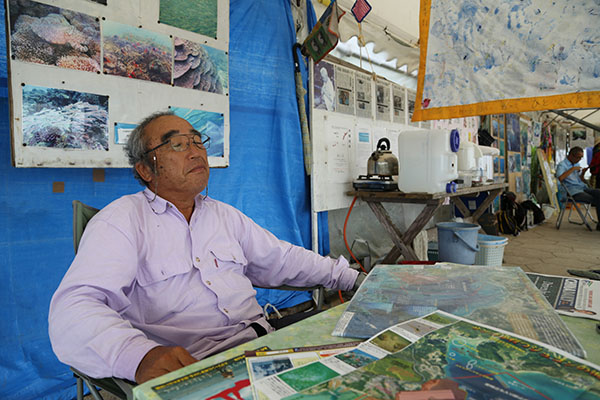Scars spur battle over Okinawa's 'war relics'
By Cai Hong and Shan Yi in Tokyo (China Daily) Updated: 2015-08-12 07:44
|
Hiroshi Ashitomi, a group leader who opposes US military bases, rests at his headquarters in a tent in Nago in front of photos of local marine life. Photo by Cai Hong / China Daily |
Activists say rest of Japan should share island's heavy burden
A simple tent sits by the seashore in the Henoko district of Okinawa's Nago city. Nearby is the area in the city of Ginowan that has been designated as the new base for US Marine Corps Air Station Futenma.
Hiroshi Ashitomi, one of the leaders of a group that opposes US military bases, calls the tent the headquarters of like-minded activists.
A wall of the tent is covered with photos of marine creatures native to the area. The activists say the new base will damage the marine ecosystem.
"The crystal-clear ocean is home to beautiful corals and is the most northerly natural habitat for the rare species of dugong, a manatee-like marine mammal," Ashitomi said, pointing to the place where a landfill project will soon be underway for the new base. "We should all strive to protect Okinawa's precious natural environment.
"This area, with a picturesque seaside and a good range of marine creatures, should be developed for sightseeing rather than a US military base."
At least 10 volunteers come to the headquarters with their lunchboxes each day, keeping a close eye on how the land reclamation is going.
Before retiring from public service, Ashitomi was a volunteer in the anti-military bases movement. He has worked hard to try to free Okinawa of such US bases for 18 years.
In the eyes of many living in Okinawa, World War II has never ended.
That is how it is for 90-year-old Masahide Ota. As a high school student, he was drafted into the Japanese Imperial Army as a member of the Blood and Iron Student Corps.
The corps was organized just before US troops invaded the southernmost part of Japan on April 1, 1945. He survived the three-month battle that the US later called the bloodiest in the Pacific War.
Ota, who governed Okinawa in the 1990s, sees the US military bases as a war relic.
The severity of the Battle of Okinawa is clear from the heavy casualties, as described in the book The Ultimate Battle: Okinawa 1945 - The Last Epic Struggle of World War II, by US writer Bill Sloan.
When the shooting finally stopped, Sloan writes, the bodies of 107,539 Japanese soldiers were counted. US losses totaled 12,274 dead and 36,707 wounded in combat. The number of local civilians killed, many by their own hands as ordered by Japanese troops, is estimated as high as 140,000, or nearly one in every three of the island's residents in 1945.





